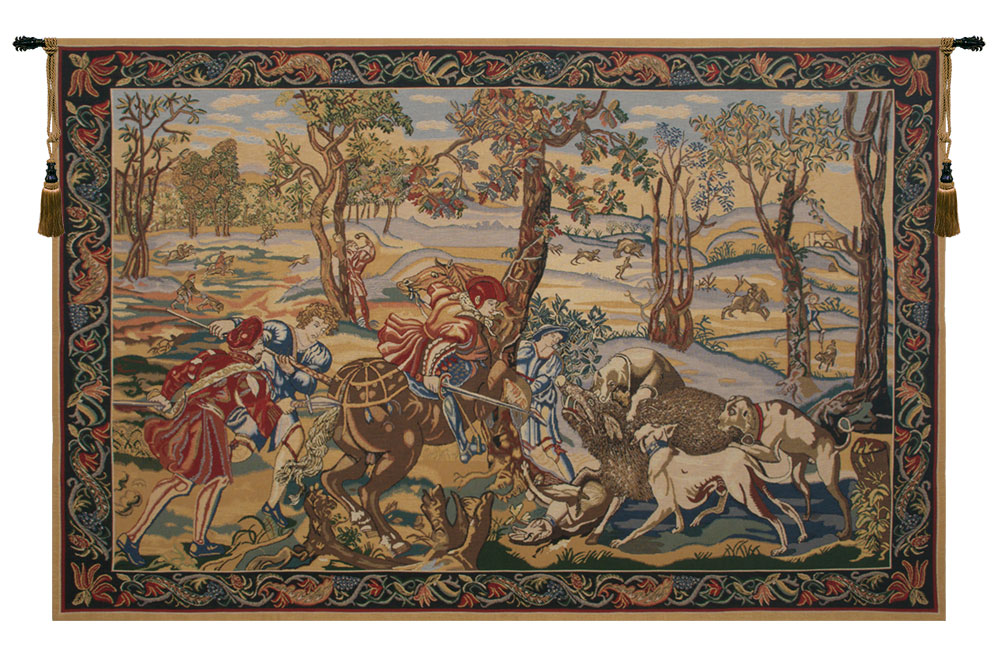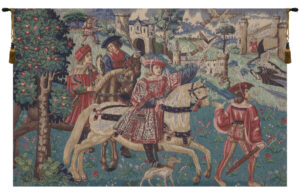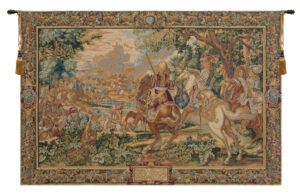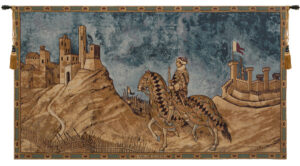
Medieval Tapestry History, Its Purpose, & Evolution in Home Decor
[vc_row][vc_column][vc_column_text]
A Stitch in Time: Medieval Tapestry History
Tapestries have stories etched in every thread. With roots in the middle ages, each tapestry was a labor of love, hand-woven by artisans whose skilled fingers breathed life into these grand textiles. They were brought to life in bustling workshops of olden times, serving as majestic wall coverings that graced the cold stone walls of medieval castles and churches, offering not just decorative flair, but much-needed warmth.
Weaving Tales: Narrative Threads of the Past
Medieval woven tapestries were more than ornamental pieces; they were windows into the world of the past. They vibrantly illustrated tales from religion, mythology, history, and courtly life. Like the famous Bayeux Tapestry, they chronicled significant events, becoming storybooks in thread, whispering tales of yore to the modern observer. Creating a medieval tapestry was no easy task. Skilled craftspeople used a special loom, which was like a big frame, to weave the threads together. They worked very carefully to make the pictures look detailed and colorful. The main material used was wool, which was strong and warm. Sometimes, they added silk, linen, and even precious metals like gold and silver to make the tapestries look even more fancy.
Medieval Tapestry History: Woven Narratives From History to Home
Medieval tapestries, woven with care and finesse in the bustling medieval workshops of Flanders and Arras, carry an undeniable sense of warmth and history. Each thread entwines to tell a story, capturing moments of the past in soft, tactile splendor. Today, these masterpieces find their place in our homes, not just as décor, but as silent storytellers. As we run our fingers over their intricate patterns or lose ourselves in their detailed narratives, we become a part of their timeless tale, inviting an echo of the past to live and breathe alongside us in our modern havens. With a Belgian tapestry adorning our walls, we don’t just own a piece of art—we partake in an enduring narrative, lovingly spun from the looms of history to the heart of our homes.
Threads of Today: Tapestries in Modern Home
As the centuries rolled on, tapestries found a new place to call home: our living spaces. History of Medieval tapestry transitioned from the grandeur of castles and cathedrals to the intimacy of our homes, adding a touch of historical charm to modern aesthetics. These tapestries, echoing tales of the past, resonate with contemporary homeowners who seek to curate spaces that reflect their unique stories.
Artistic Alchemy: Evolution of Design in Blending the Old with the New
In the cozy corners of modern homes, tapestries come alive, standing as proud centerpieces that infuse rooms with warmth, texture, and depth. They converse with the viewer, making bold statements, bringing an air of elegance, and kindling discussions. Medieval Tapestry history is more than fabrics on the wall; they are companions that bring spaces to life, marrying historical tradition and contemporary style in a harmonious union.
Embracing Green: Tapestry in Modern Sustainability Trends
Adding to their charm, tapestries are now also champions of the earth. Modern weavers are responding to our collective call for sustainability, creating tapestries with environmentally friendly materials and processes. The slow design of tapestry-making — meticulous, time-demanding — serves as a soothing antidote to today’s fast-paced, throwaway culture.
From Heart to Home: Timeless Appeal of Tapestries
The tale of tapestries is one of evolution, resilience, and undeniable appeal. These captivating creations have traveled through centuries, transforming from the grand wall hangings in medieval castles to the alluring accents in modern homes. They carry with them not just a sense of history, but an uncanny ability to connect with people, engaging them in a shared narrative that stretches across time.
Conclusion:
In this article we have shared some amazing facts and Medieval Tapestry history. If you’re looking to make a statement in your living space, consider adding a tapestry. It’s an embrace of history, an appreciation of art, and an invitation to a narrative that threads together past, present, and future. As you sit back and gaze at the tapestry on your wall, you partake in a shared human experience, an endless conversation spun across centuries. Amid the hues and textures of your chosen tapestry, you’ll find your unique story intertwined with those of countless others, reminding us that we are, after all, part of an ever-evolving, beautiful tapestry of life. Medieval tapestries are like magical windows to the past. They tell stories, show us colorful pictures, and give us a glimpse into the lives of people who lived in medieval times. These incredible artworks were made with skill and care, using special threads and materials. Today, we are lucky to have these ancient tapestries preserved in museums, reminding us of the amazing craftsmanship and history of the Middle Ages.[/vc_column_text][/vc_column][/vc_row]


